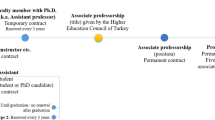Abstract
A susceptibility parameter called the “intelligence constant” by which it is possible to assess the complexity of scientific research in the different periods in history is suggested. In scientific sense, the intelligence constant measures creative energy expended in the achievement of a major scientific result. It is demonstrated that the sudden change of intelligence constant signalizes a scientific revolution and so the law of intelligence constant change might provide a particular method to forecast scientific revolutions in the future.
Similar content being viewed by others
Notes and references
D. PRICE, The productivity of Research Scientists,Encyclopedia Britannica, 1974, 409–421.
W. DENNIS, Creative productivity between the ages of 20 and 80 years,Journal of Gerontology, 21 (1966) 1–8.
B. L. GEANZBURK,Nature (in Russian), 6 (1976) 73.
T. KUHN,The Structure of scientific revolutions (2nd ed.), University of Chicago Press, Chicago, 1970.
H. C. LEHMAN,Age and achievement, Princeton University Press, Princeton, N. J. 1953.
D. PRICE,Science Since Babylon, New Haven, 1961, p. 96.
D. PRICE, Regular Patterns in the Organization of Science,Organon, No. 2 (1965) 244–245.
D. PRICE,Little Science, Big Science, Columbia University Press, New York, 1963.
D. PRICE,Ups and downs in the pulse of science and technology, The Sociology of Science, Ed. J. GASTON, Jossey-Bass, San Francisco, 1978, 162–171.
D. K. SIMONTON, Times series analysis of literary creativity: a potential paradigm,Poetics, 7 (1978) 249–259.
D. K. SIMONTON, Creative productivity, age, and stress: a biographical time-series analysis of 10 classical composers,Journal of Personality and Social Psychology, 35 (1977) no. 11. 791–804.
M. YUASA, Japanese Studies in the History of Science, 1 (1962) 57.
M. YUASA, The shifting center of scientific activity in the West. in: S. NAKAYAMA and other (Eds),Science and Society in Modern Japan, University of Tokyo Press, Tokyo, 1974.
H. ZUCKERMAN,Scientific Elite, Free Press, New York, 1977.
ZHAO HONG-ZHOU,Journal of Dialectics of Nature (in Chinese), No. 4. (1979).
G. L' E. TURNER,The Patronage of Science in the Nineteenth Century, Noordhoff International Publishing, 1976, p. 7.
Author information
Authors and Affiliations
Rights and permissions
About this article
Cite this article
Hong-Zhou, Z. An intelligence constant of scientific work. Scientometrics 6, 9–17 (1984). https://doi.org/10.1007/BF02020109
Received:
Revised:
Issue Date:
DOI: https://doi.org/10.1007/BF02020109




